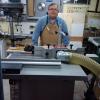I need a joint where the flat arm of a Morris-style rocking chair connects to the front leg. I don't want to use the traditional through mortise and tenon that protrudes through the face of the arm because I won't be able to set my coffee cup down on it. But other chairs like this are notorious for the joint failing over time and the arm coming loose every time you move the chair by the arms.
The arm is 7/8' bent lamination, but 4' wide so it would be hard to run a screw through it and then through the tenon. I thought maybe cutting two rounds rather than one round or square mortise might provide more glue surface. I've only got about 1/2-5/8" to work with for the tenon on the leg so I'm guessing an angled tenon wouldn't work. Or should I use a regular mortise and tenon, but use epoxy instead of wood glue? Any ideas for a joint that will last? I'm a brand new Gramma, so this has to be good.




 Reply With Quote
Reply With Quote







